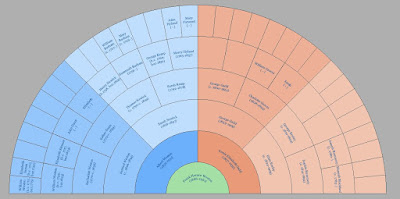No, not another railway ancestor but another of the Weston families and this time they are missing in the 1901 census, every single one of them.
I had been researching the family of my 2x great uncle, Samuel Weston born 1840 in Etchingham, Sussex and using a timeline technique to identify missing records for them. Firstly I researched Samuel’s marriage to Jane Pilbeam in 1865 and then used baptismal records and the GRO indexes to find their children; Caroline Jane 1866, Alfred John 1868, Richard Samuel 1870, William Rowland 1872 and Eliza Ellen 1875.
Samuel Weston and Jane Pilbeam
As expected, the 1871 census showed Samuel and Jane in Burwash, with their eldest three children and Jane’s, mother who was a widow. In 1881 census they are in Etchingham but Caroline and Eliza are missing. Time to check the death records and indeed I found them both. Caroline dies in 1880 aged 14 and sadly Eliza died in 1875, the year she was born. In 1891 only William remains with his parents and in 1901 ……they were missing!!! Death records didn’t help here.
Further research showed Richard Samuel had emigrated in July 1888 and Alfred John in 1890. Delving further showed the last son, William Rowland had emigrated in the summer of 1891 and finally Samuel and Jane must have plucked up courage to go off and join the family in Portsmouth, New Hampshire, America and they emigrated in 1893 aboard the SS Catalonia.
American records and newspaper enabled me to find the details to complete my research of this family including showing that Samuel lived to the ripe old age of 99 years and 3 months!!
Looking further at American records showed that one of Samuels cousins on his mother’s side (Newick) had already emigrated in the 1870s and in fact in America there were marriages between the Westons and the Newicks. Samuel’s eldest son, Alfred John, married his second cousin, Harriet, who had been born in America. Samuel is both her father in law and a 1st cousin once removed!!
Samuel Weston was an agricultural labourer living in farm cottages; it must have taken him quite a while to save sufficient funds to emigrate whilst supporting his family. It was probably quite a while after electric lighting started appearing in streets and houses in 1881 that landowners would have modified the cottages of agricultural labourers. I also doubt they champed at the bit to purchase any of the first Kodak cameras that was invented in 1884 or even bought newspapers that would have brought news about the Jack the Ripper murders and professional football that also started in 1884. The event that probably affected them most would have been the Great Blizzard in 1891which caused the death of over 200 people and 6000 animals and Devon and Cornwall were cut off for 4 days from 9th and 13th March. The devastation left behind included uprooted trees and many fences and roofs were blown away also. The strong gales and heavy snowfall hit Cornwall, Devon, Dorset, Herefordshire and Kent. Temperatures dropped below zero and snow drifted in places up to 15 feet high. A man froze to death in Surrey and fishing boats washed up at Hastings and 3 fishermen lost their lives so I wondered how that affected my Sussex ag labs. Samuel’s last son emigrated in the summer that year ….. perhaps he decided he had had enough!!













